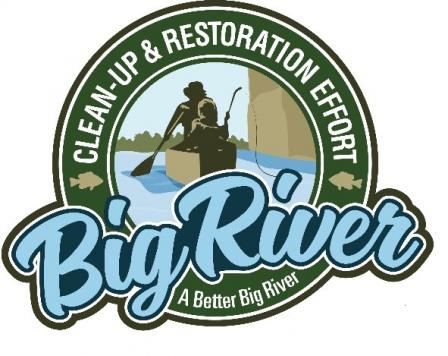The Big River Clean-up and Restoration Effort is a coalition of federal, state and non-governmental organizations dedicated to restoring the Big River with the support of landowners and the public. As a result of decades of lead contamination from mining, the coalition’s work informs, educates, and involves communities about lead prevention and river restoration strategies that protect human health and the environment.
The coalition is working toward "A Better Big River” A Better Big River is one that is vibrant with life. Families are safeguarded from the harms of decades of lead-mining pollution. A thriving clean river sustains wildlife and aquatic species and provides recreational opportunities for years to come.
The Big River is the largest tributary to the Meramec River located southwest of St. Louis, Missouri, and like the Meramec, has great potential recreational uses, including fishing and canoeing, but is largely underutilized. The Big River Watershed encompasses three counties: St. Francois, Jefferson and Washington.
The Big River Clean-up and Restoration Effort, initiated by the EPA, the U.S. Army Corps of Engineers, the U.S. Fish and Wildlife Service, Missouri Department of Natural Resources, and Missouri Department of Conservation, includes a diverse team of natural resource specialists, conservation specialists and public health specialists working to improve the public’s and the river’s health. Members of Big River Clean-up and Restoration Effort include:
-
U.S. Army Corps of Engineers
-
U.S. Environmental Protection Agency
-
U.S. Fish and Wildlife Service
-
U.S. Department of Health and Human Services/Agency for Toxic Substances and Disease Registry
-
Missouri Department of Natural Resources
-
Missouri Department of Health and Senior Services
-
Missouri Department of Conservation
-
The Nature Conservancy
-
East-West Gateway Council of Governments
Since the 1700s, Missouri has been one of the world’s largest lead-producing regions. Consequently, the Big River watershed today faces severe lead contamination, posing a serious threat to human health and wildlife, especially to mussel and fish populations. So far, EPA has stabilized the major lead mining waste piles upstream of the river and floodplain and has initiated the cleanup of residential properties in many impacted areas of St. Francois, Jefferson and Washington counties. Periodic flooding along the Big River can introduce contaminated river sediments to flooded properties. EPA is remediating contaminated soil in residential yards at no cost to the property owner.
The Big River Clean-up and Restoration Effort is focusing efforts to restore, remediate and revitalize the Big River watersheds by engaging partners, local organizations and landowners. Together, we need support to:
-
Remove built up contaminated sediment from behind dams and other structures,
-
Restore trees and vegetation along the riverbank,
-
Stabilize eroding riverbanks with engineered designs using trees, shrubs and rocks,
-
Restore native mussels, crayfish, and fish, and
-
Address contaminated yard soil.
Currently, agencies have funds dedicated to clean up and restoration of the river. Due to the large scope of the project, it is expected that additional funding will be necessary to achieve agency goals.
Lead is a toxic metal that is harmful if inhaled or swallowed. Lead exposure, through interaction with contaminated soils and sediment, and consumption of locally caught fish, can be especially harmful to pregnant women and young children. Exposure has been linked to negative health effects in developing fetuses and infants including nervous system development, muscle and bone growth, and learning disabilities and disorders. Protect your family by regularly washing your hands after exposure to soils, removing dirt tracked into homes, cars, boats and vehicles, and eating a high calcium and iron diet.
The only way to know if your child has elevated blood lead levels is to have his or her blood tested. EPA encourages parents to have their children tested for lead exposure. Contact your physician or local county health department to get your child tested for lead.
View the resources box below for outreach materials and messages about how to prevent lead exposure.
Follow the Big River Clean-up and Restoration Effort on Facebook.
List of Partners:







